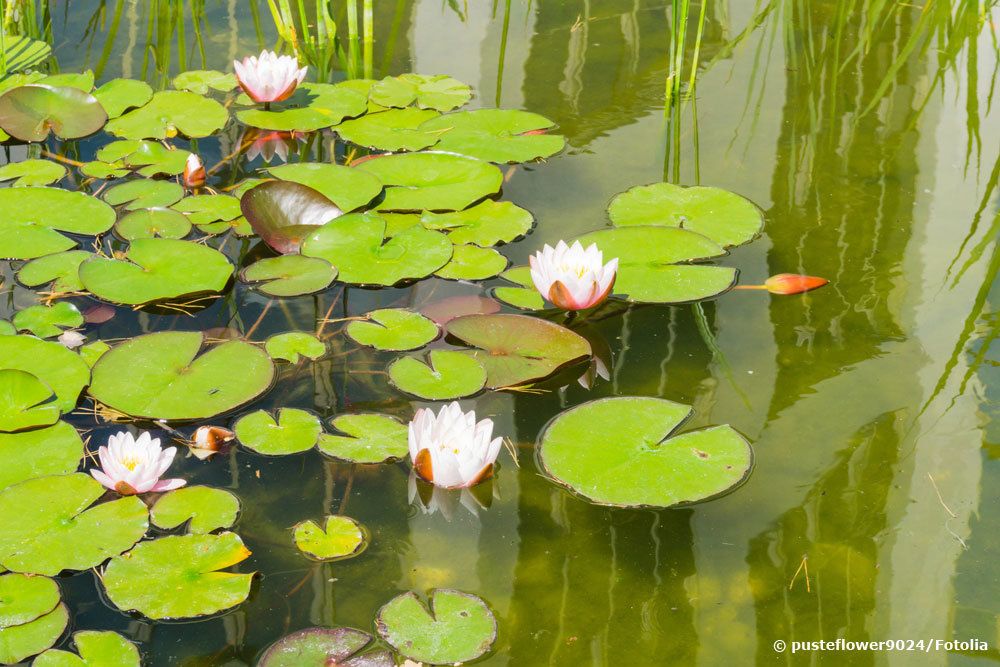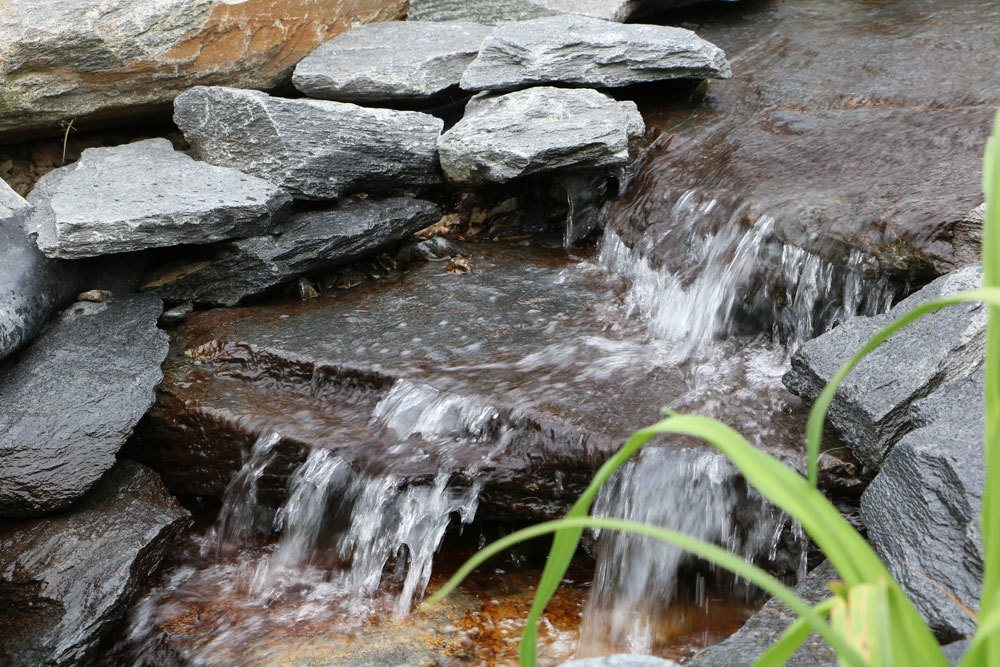Different types of algae can be found in every pond. They are essential for life, serve as food for microorganisms such as water fleas and are an important supplier of oxygen in the water due to their photosynthesis. Occurring in moderation with a normal nutrient concentration in the pond, there is no reason for concern. However, if they occur in masses, it is a sure sign that the balance of the pond is out of joint. Then quick action is called for.
Contents
- 1 Suspended algae
- 2 Causes
- 3 Why remove algae?
- 4 Removing algae
- 5 UV-C water clarifier
- 6 Pond pump directs water through UV-C water clarifier
- 7 Water depth and light conditions
- 8 Water movement
- 9 Pond plants
- 10 Pond cleaning
- 11 Mineral binders
- 12 Algaecides – algae killers
- 13 Preventing algae growth
- 14 choose the right location
- 15 Author
Suspended algae
Colloquially, this type of algae is also called green algae. They are microscopically small and float freely on the water surface as a green visible veil. Especially in spring, when the nutrient supply in the pond is still very high, because the water plants and other microorganisms are not yet active, floating algae develop explosively. This process is also known as algae bloom. This is characterized by
- turbid and green water
- a visibility depth of only a few centimeters
Tip: Normally a slight turbidity of the water is completely normal also in natural waters. A visibility depth of about one meter is sufficient.
During the algae bloom, organic material is formed by the algae, or they die and sink to the bottom. There it begins to decompose into a layer of mulch, but in the process deprives the water of oxygen. This layer of mud in turn forms the basis for new algae growth.

Causes
However, excessive algae growth is not always a sign of an ecological imbalance in the pond. Algae growth can be observed especially in newly created ponds or also during water changes. However, it subsides after one or two weeks. Normally, a low concentration of floating algae in the pond is not a cause for concern. However, they can multiply quickly with suitable conditions.
- Increase of water temperature
- sunshine in spring and summer
- high nutrient content of the water
- increased phosphate content
Phosphate is the basic nutrient for algae. Therefore, floating algae find very good conditions for rapid reproduction in ponds with increased phosphate content. Even a concentration of phosphate above 0.035 milligrams per liter can lead to an algae bloom.
Excessive phosphate levels in water can have several causes:
Washing in nutrients from the environment through rain (lawn fertilizer, nutrient-rich soil)
excess fish food and fish droppings at the bottom of the pond
dead algae
Why remove algae?
In principle, algae are useful plants in the pond. They extract nutrients from the water and provide oxygen in return. Normally no other plant or even technique is as effective as floating algae are.
- every second oxygen molecule comes from algae
- convert three times more carbon dioxide into oxygen than any other useful plant
On the other hand, algae also extract as much oxygen from the water at night as they produce during the day. Due to many suspended algae in the pond, there are strong oxygen fluctuations between day and night. A deficiency can very quickly become a threat to aquatic plants and fish. Further side effects of an excessive algae population are for example
- a low KH-value of the water (carbonate hardness) and
- an increased pH-value
It should also be noted that dead algae on the bottom release nutrients as they decay with the help of oxygen. The resulting layer of mulm forms the basis for renewed algae growth. If nothing is done, the pond will eventually become silted up over time.
Tip: Normally, some patience is required when an algae bloom occurs. Usually, the algae themselves will break the reproduction cycle after two to three weeks.
However, if it does not, then action must be taken.
Removing algae
Now there are several methods to banish algae from the garden pond. The specialized trade offers various means. However, it should be borne in mind that here partly only the symptoms are fought and not the causes. The water is thereby clarified, but the algae growth continues. Especially when algae occur more frequently, quick action is necessary. Sometimes pond filters are no longer sufficient here, because the algae can not be absorbed by the filter due to their size. There are other solutions for this:
UV-C water clarifier
A permanent solution for algae control is the use of a UV-C water clarifier in the pond. However, this UV-C lamp lasts only one pond season. Therefore, it should be replaced every year in spring. The function of this device is relatively simple:
Pond pump directs water through UV-C water clarifier
- then reaches the mechanical filter
- ultraviolet light destroys genetic information of algae there
- algae clump together
- Filter removes residues
- UV irradiation is not dangerous for the pond and its inhabitants
- UV-C lamp already integrated in many pond filters
- if not, easy integration into water circuit possible
- important installation in front of filter, otherwise no absorption of algae residues
- Pond sludge suction cleaner and skimmer
Both devices are reliable helpers in pond maintenance.
Sucker removes nutrient-rich sediments from the bottom
Skimmer removes floating foreign matter
Water is sucked up at the pond surface and directed to the filter
Water depth and light conditions
Plenty of sunlight accelerates algae growth, so a garden pond should have at least one-third shade. The amount of water and water depth also have a direct impact on the development of algae. For example, small, shallow ponds are much more likely to have algae problems than larger systems. Using a variety of plants to provide shade can be helpful:
- Plants with large floating leaves (water lily, lotus, sea pot, frogbit).
- plants under the water surface with simultaneous purifying effect such as water lily and waterweed
- for the shore zone: water nettle, loosestrife, bulrush, arrowhead, iris
- when planting, do not add too much nutrient-rich soil to the pond
- Use special aquatic plant soil
- Tip: Regularly check the pond water with pond test set. Ideal GH value (hardness of water) should be between 8 and 12 dH.
Water movement
It is generally known that constant water movement is not very conducive to the development of algae. It is therefore advisable to think about alternatives such as
- installation of fountains or watercourses
- simply placing a stable oak branch in the water
- thereby lowering the pH value by releasing tannic acid
- bad living conditions for algae
- remove branch before decomposition, otherwise process is reversed
Pond plants
Water plants are a kind of biological filter. Strongly growing plants remove nutrients from the water. The more plants are present in a pond, the less food then remains for the algae. Therefore, they should not be missing in any pond.
- Water plants are the biggest food competitor for algae
- cover about one third of the water surface with plants
- especially suitable hornwort, milfoil, waterweed, frogbit, crayfish, duckweed
- Thin out plants from time to time due to strong growth
- cuttings can be put on compost
- regular fishing of algae with a special algae net
- Algae can be composted well
- Ideally, a balance is achieved in the pond
- Fish and other aquatic animals
- Fish and other small aquatic animals also function like a biological filter.
- However, care should always be taken to limit the number of animals. If possible, they should feed on the natural food sources in the pond (e.g. algae). An additional addition of fish food would in turn increase the nutrient content of the pond.
- for larger ponds grass carp, silver carp or koi carp
- Caution: eat also smaller fish and soft pond and underwater plants
- for smaller ponds rudd, goldfish
- also use water fleas, European freshwater shrimps and pond mussels
- snails are also algae eaters (swamp cover snail, post horn snail pointed mud snail, small mud snail)
- water fleas have already eaten up all water turbidity by the middle of May
- besides in fish ponds filter system necessary for the disposal of surplus nutrients
- especially for big fishes install additional technology
- do not use animals from native waters (nature conservation)
Pond cleaning
The most effective way to combat algae in the garden pond is undoubtedly a complete cleanup of the small body of water. However, there are a few things that should be taken into account:
- not only replace water
- thoroughly clean all utensils
- remove mulch from the bottom of the pond
- replace old pond soil with new low-nutrient substrate
- use low-nutrient sand (as little as possible)
- cut back plants vigorously and divide if necessary
- place in new low-nutrient pond soil and special plant baskets or embankment mats
- especially tested tap water is suitable for filling
- sometimes tap water enriched with up to 5 milligrams of phosphate per liter (protects pipes from corrosion)
- if much phosphate contained, use phosphate binder
- ground water is more suitable, it is low in phosphate
- rainwater would be optimal
Tip: Smaller ponds can be covered with small nets in autumn. This prevents leaves from getting into the water.
Mineral binders
These agents, which are offered by specialized dealers, eliminate the symptoms, but not the cause. Very popular here are flocculants for quick clarification of the water such as.
phosphate binders:
- is not absorbed by algae or other aquatic plants
- binds phosphate by chemical processes
- thus depriving algae of their nutritional basis
- different agents available
- either sprinkle directly into the pond water
- others directly into the filter
- harmless for fish
Algaecides – algae killers
Here, too, different agents are available in specialized shops. Although the use of these agents quickly leads to clarification of the water, the causes are not eliminated. However, if used continuously and in the wrong dosage, these agents are harmful to fish and other microorganisms.
- partly occurs clumping of the algae
- absorption then through the filter
- other agents contain monolinron or copper sulfate
- use only with exact knowledge of the pond volume because of correct dosage
- do not use permanently
- if the water values do not correspond to the recommended values – the agent is ineffective.
- Tip: It is recommended to measure the visible depth in the pond. This provides information about the success of the algae control. To do this, dip a folding rule into the water until the tip is no longer visible.
Preventing algae growth
Already when creating a new garden pond, a few things can be done to prevent algae from spreading in masses in the pond. Some factors have to be considered:
choose the right location
- mineral fertilizers and garden soil from the surrounding area can get into the pond
- better place on a slight hill
- not directly under trees (leaf fall – nutrient enrichment)
- one third should be in the shade
- surround the pond with a 60 cm deep drainage trench
- fill it with coarse-grained building sand
- create different levels (sump zone, shallow water, deep water)
- place suitable plants in the individual zones
- consider the size of the pond
- must be large enough that water does not heat up so quickly
- the smaller and shallower, the more frequent algae problems will be
- minimum depth one meter, better even deeper


